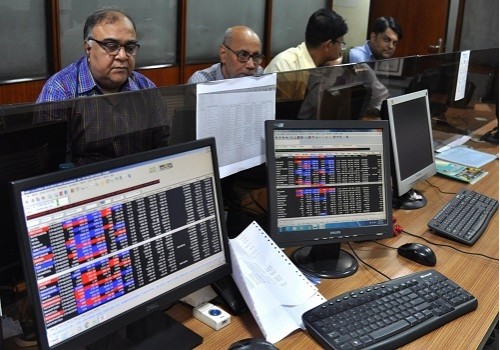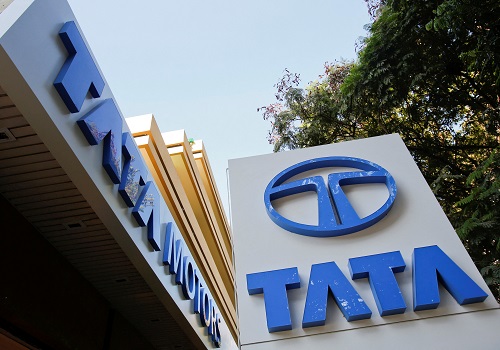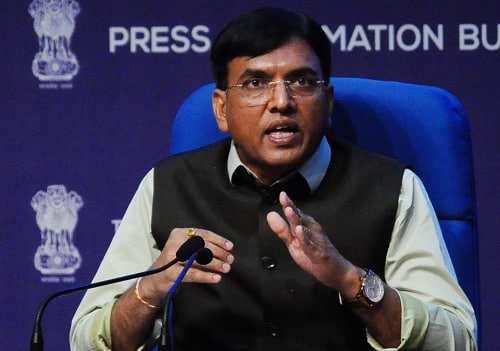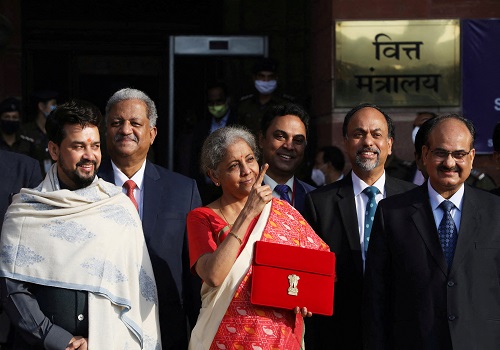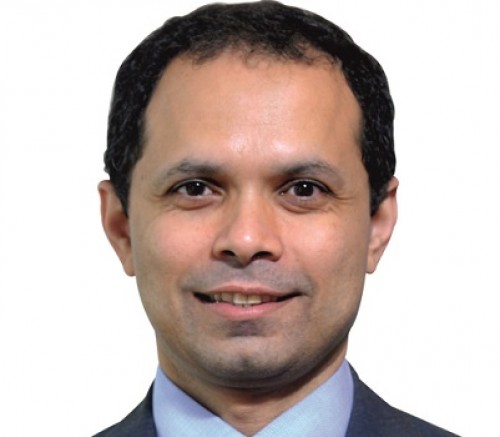Budget Recommendation note by Jimmy Patel, Quantum Mutual Fund

Follow us Now on Telegram ! Get daily 10 - 12 important updates on Business, Finance and Investment. Join our Telegram Channel
https://t.me/InvestmentGuruIndiacom
Download Telegram App before Joining the Channel
Below are Views On Budget Recommendation note by Jimmy Patel, MD & CEO, Quantum Mutual Fund
1. Introduce Debt Linked Savings Scheme (DLSS) to deepen the Indian Bond Market
* Minimum of 80 % of funds under the category of Debt Linked Savings Scheme (DLSS) shall be invested in debentures and bonds of companies that are permissible under SEBI Regulations.
* DLSS should be introduced similar to Equity Linked Savings Scheme (ELSS) to generate potential returns for long term savings of retail investors into corporate bond markets which also helps boost the Indian Bond Markets.
* Pending investment of funds may be invested in short term money market or liquid instruments or both.
* Investments up to ₹1,50,000 under DLSS be eligible for tax benefit and subject to a lock in period of 5 years i.e. similar to bank FDs.
* Since banks may not be equipped for massive investment and funding for infrastructure the government intends to increase it by raising funds from the large borrowers from the market.
This may attract more investors while also generating liquidity in the market.
* An active corporate bond market shows stronger market sentiments and consequently lower risks and lesser dependence on local currency.
* Therefore it is essential to channelize long term savings of retail investors into corporate bonds markets to deepen the Indian bond market and strengthen the efforts taken by RBI and SEBI for increasing its penetration in the bond markets
* In 1992, the government introduced the concept of Equity Linked Savings Scheme to upliftequity investing in the nation. This has proved to be a progressive move over the years.
* DLSS may mobilize small investors to participate in bond markets at low costs and at a lower risk as compared to Equity markets.
* We believe that debt oriented mutual funds are on par with tax saving bank fixed deposits, where deduction is available under Section 80C.
2. Uniform tax treatment in respect of investments in Mutual Funds Units and ULIPs of Life Insurance companies
* Standardizing tax treatments for switching Investments under Mutual Fund schemes and ULIPs of Insurance companies.
* Exemption of payment under capital gains tax since it is termed as intra scheme switches and not ‘Transfer’.
* Switching of Units within the same scheme of a Mutual Fund .There are no realized gains, as the underlying securities/ portfolio remains unchanged, being common for both Options.
* SEBI has emphazised the need of uniform tax treatment for ‘switch transactions from insurance products to mutual fund investment schemes to have a common platform to benefit all investors.
* Uniform tax treatment on Capital Gains from Mutual Funds investments and ULIPs of Insurance companies.
* Prioritizing the interest of retail investors is most important. We must also ensure there is a common bridge between mutual fund schemes and ULIPs.
* Retail investors may get confused between a pure investment product like MFs and insurance products with equity exposure. It is essential to relook at high commissions and incentive structure prevailing in life insurance sector.
* Removal of Tax Arbitrage between ULIPs & Equity MF Schemes on account of STT.
* Maintaining the interest level of the retail investors, having a common sync between MF schemes and ULIPS of insurance companies.
3. Uniform Tax Treatment for Retirement / Pension Schemes of Mutual Funds and NPS
* Under Section 80CCD tax deduction for Investment in Retirement Benefit / Pension Schemes
offered by Mutual Funds up to ₹150,000 should be allowed within the maximum limit of 1.5
lakhs with additional deduction for investment up to ₹ 50,000 under section 80CCD. Also the net
total of employer’s and employee contribution should be taken into account for the benefit of
tax calculation under section 80CCD.
* Eligibility of an employer should be allowed as an eligible ‘Business Expense’ under Section 36(1)
of Income Tax Act, 1961. Also contributions made by them to Pension Schemes up to 10% of
salary should be deductible in the hands of employee, as in respect of Section 80CCD(2). In
addition, withdrawals made by employees for the same should be exempted from income tax as
limits explained in the sections.
* Also recommended that CBDT, in consultation with SEBI, should NOTIFY the guidelines giving the
framework for Mutual Funds to launch pension schemes for tax eligibility and norms adhering to
it.
* With a large ageing population, increased longevity and consequently growing health care needs
and medical expenditure, there is a strong need for individuals to set aside funds for a long term
pension product that could provide decent inflation-proof savings. Considering that India's
population is around 1.34 billion is around 10 percent, therefore pension funds in India have, a
large potential as a social security measure and needs to be given due importance.
* Forecasting scope for growth in India’s retirement benefits market as the existing investors are
low but has potential to grow in the future especially in the unorganized sector.
* Globally, market-linked retirement planning has been a boon for high-quality retirement
savings. Investors will have many choices in scheme selection and flexibility.
* Long Term Policy for Mutual Funds under SEBI classification Mutual Fund Linked Retirement
Plan’ (MFLRP) which would be eligible for tax benefits akin to 401(k) Plan of the U.S
* MFLRP may play a significant role in channelizing household savings into the securities market
and penetrating deeply in the financial markets. That would also help in mitigating risk and
reducing volatility in the capital markets
* MFLRP would help investors gain investment expertise from a large talent pool of asset
managers of mutual funds efficiently with the support of research teams.
* MFLRP could target individuals who are from the unorganized sector and also have the flexibility
to save for the long term, coupled with tax benefits.
4. Mutual Fund Units should be notified as ‘Specified Long-Term Assets’ qualifying for exemption on Long-Term Capital Gains under Sec. 54 EC
* MF units that are redeemable after three years, wherein the underlying investments are in equity or debt of ‘infrastructure sub-sector’ as specified by RBI, should also be included in the list of the specified long-term assets under Sec. 54EC.
* The investment shall have a lock-in period of three years to be eligible for exemption under Sec. 54EC as well as providing the option equity, or debt schemes based on each individual’s goals.
* Long term capital gains could be saved by the investor as it could be reinvested in other MF schemes along the same lines for sale of transactions of immovable property.
* With the growing demand of increased expenditures in housing, buying property, investment in infrastructure has been a boon to the real estate market. It is likely that most individuals liquidate their financial assets to purchase residential property resulting no reinvestment in capital market. Therefore this transaction of moving money has become irreversible. Thus it is important to channelize long term savings into capital markets with the help of tax incentives given by the government through MF schemes.
* A lock in period of three years is a necessity for both equity and debt schemes in order to reverse the one way street for investors from real estate to capital markets.
5. Mutual Fund Units should be notified as Long-Term Specified Assets qualifying for exemption on Long-Term Capital Gains under Sec. 54 EE
* Recommendation for a lock-in for three years may be notified as “Long term specified assets” under Section 54EE for MF units issued under SEBI rules and regulations.
* Announcing the MF investment units as Long term specified assets under Section 54EE would encourage individual tax payers to invest in capital markets through MF’s and channelizing long term household savings into Capital Market.
* Suggest exemption from capital gains tax for net consideration in investment for certain specified assets including MF units i.e. is withdrawn after 3 years, shall be made provisions for. They also serve as a great boost for investors wanting to invest in MF schemes debt or equity.
6. Taxation on Listed Debt Securities and Debt Mutual Funds to be aligned
* There needs to be an aligned holding period for long term capital gains between investment in listed debt securities and debt mutual fund schemes.
* Investing in non-equity oriented schemes where 65% or more is invested in long term debt securities could bring the common platform and pave the way for direct investment as mentioned in the above point.
* Parity between direct investment in listed debt instruments and investment in debt-oriented mutual fund schemes is the need of the hour.
7. Definition of Equity Oriented Funds (EOF) to be revised to include Equity Oriented “Fund of Funds”
* “Equity Oriented Funds” (EOF) which invest predominantly, say 65% or more, in units of Equity Oriented Mutual Fund Schemes should be exempted from ‘tax on distributed income’ under section 115R. Also redemption of units in such schemes should be allowed same capital gains tax that is applicable to sale of listed equity securities / units of Equity Oriented Mutual Fund Schemes
* Need to revamp this strong case for rationalization of taxation between Equity and Equity Oriented Fund of Funds. Reconsidering, FOFs investing 65% or more of their corpus in EOF should be reclassified as EOF’s.
* To recognize and ensure that the intent of the law is not sacrificed, the minimum allocation of an FOF investing in the major asset class may be set at a higher level, say 90% for such eligibility. In the absence of such higher allocation, a FoF investing more than 65% in funds that invest at least 65% in equities may attract equity taxation while theoretically investing merely 42.25% in equities.
8. Incentives for Economy Growth
Two key problem areas for the Indian economy have been falling discretionary spends and lack of private capex.
* Incentivsing private capex in infrastructure creation must be a priority area. The 2003-2007 boom was led by string uptick in private capex as well as infrastructure creation by private players. A similar boom can pull up the GDP growth as well as have a strong multiplier.
* Incomes have taken a significant hit due to the Covid virus and one expects the government to breach the gap caused by falling consumer spends. Direct fiscal support remains the best course of action followed by most international governments. So far the fiscal response has been weak from the India government given the scale of the slowdown. One expects the Government to increase its fiscal response to stimulate demand either via direct income support of cut in taxes for most affected sectors.
9. Removal of Customs Duty on Gold : Reduce customs duty and provide a road map towards
removing it completely
* In Indian gold market, high customs duty only distorts markets further as the current differential between the Indian gold prices and International gold price has widened to 15.5% in total. The way the math works is 12.5% customs duty + 3% GST leads to 15.5%. This is a significant differential and augurs well for illicit gold imports and further distort gold markets significantly.
* We have seen Indian physical gold markets trade at a discount almost persistently and reasons cited by the experts are lower demand and illicit imports at the root cause. Such interventionist policy making ensures that India will never be at the center of the global gold markets despite been the largest consumer and will continue to remain a price taker.
* Such distortions make it difficult to channelize the hoard of India’s gold savings into circulation and thereby integrate the gold market with other financial markets. For instance, the recent introduction of TCS also leads to price distortions in the gold market.
* Historically, while the authorities have pursued policies to de-emphasize gold and to suppress demand
for gold, the balance sheet of households showed more gold on the asset side.
* The Committee on Capital Account Convertibility (CCAC) put forward some precise and action-oriented recommendations on the liberalization of the gold market. The CCAC stressed that it was essential to liberalize the policy on gold while simultaneously taking steps to develop a transparent and well- regulated market in gold, which would be integrated with other financial markets (China is moving in this direction). In its view, the main ingredients of the change in the policy on gold should be:
* Removal of restrictions on import and exports of gold,
* Development of gold-related financial instruments,
* Development of markets for physical and financial gold,
* Encouragement of banks and non-banks to participate in the gold market.
The CCAC suggested mobilization of private sector gold for external adjustment and to remove external
constraints. Removal of tariffs and freeing the market are the prerequisites for this development.
What the Indian gold markets need for it to influence global gold markets:
* A gradual move towards a free market, which allows imports and exports of gold to be made freely or with minimal restrictions. Get domestic prices on level with international prices so as to bring about an efficient two way transfer of the commodity or currency. This will help lay down some basic rules in order to find the true price of that commodity or currency. For this to become successful, additional taxes, duties and levies need to be abolished.
* There is a huge amount of accumulated wealth of gold in India. The government should try to use these savings for the development of the nation by mobilizing and channelizing the same to productive uses. Price distortions will only push further any real chances of bringing gold in circulation.
* If the motive is to generate revenues, there are many other ways post the market development. The government could apply an annual fee on foreign bullion players trading in Indian markets and raise revenues through the fees charged on them. The customs duty collected helps reduces the deficit by a negligible proportion. Hence, the government should focus on implementation of reforms and look at the bigger picture to develop the gold market as it truly possesses the potential of becoming the gold trading capital of the world.
* We agree that these reforms cannot be achieved overnight. However, these are essential steps towards strengthening our gold market which would enable us to further cement our position as world leaders in the global gold market.
Above views are of the author and not of the website kindly read disclaimer










Tag News

We anticipate immense potential benefits from the upcoming Sovereign Gold Bond Tranche in FY...

